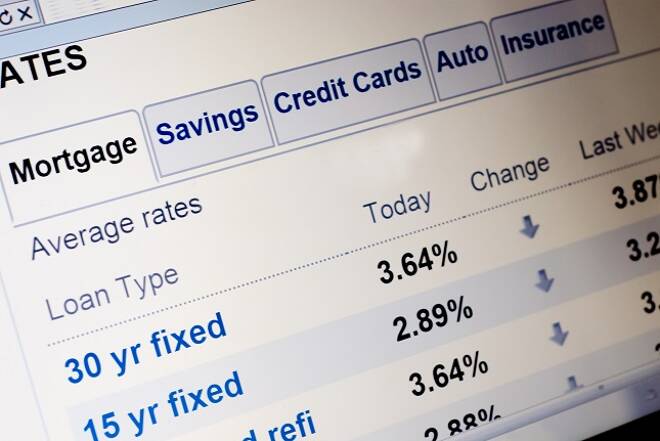Advertisement
Advertisement
U.S Mortgages – Up 4-Weeks in a Row, a 5th Looking a Stretch
By:
Up for a 4th week in a row, rates may head south in the week ahead, Trump likely to ruffle the UN's feathers and trade talk in Focus.
U.S mortgage rates rose for a 4rd consecutive week, in the week ending 20th September, with mortgage rates hitting their highest levels since the beginning of May, 4 weeks of rises reversing 3 previous weeks of decline with interest.
Freddie Mac weekly average rates for new mortgages as of 20th September were quoted to be:
- 30-year fixed rate loan increased from 4.6% to 4.65% in the week, while up from 3.83% a year ago. The average fee remained unchanged at 0.5 points.
- 15-year fixed rates rose from 4.06% to 4.11% in the week, while up from 3.13% from a year ago. The average fee remained unchanged at 0.5 points.
- 5-year fixed rates slipped from 3.93% to 3.92% in the week, while up from last year’s 3.13%. The average rose from 0.3 points to 0.4 points.
Mortgage Bankers’ Association Rates for the week ending 14th September were quoted to be:
- Average interest rates for 30-year fixed, backed by the FHA, increased from 4.84% to 4.90%, with points increasing from 0.51 to 0.73 (incl. origination fee) for 80% LTV loans.
- Average interest rates for 30-year fixed with conforming loan balances increased from 4.84% to 4.88%, its highest level since April 2011, with points falling from 0.46 to 0.44 (incl. origination fee) for 80% LTV loans..
- Average 30-year rates for jumbo loan balances increased from 4.72% to 4.77%, with points easing from 0.47 to 0.28 (incl. origination fee) for 80% LTV loans.
Weekly figures released by the Mortgage bankers Association showed that the Market Composite Index, which is a measure of mortgage loan application volume, rose by 1.6%, reversing most of the previous week’s 1.8% decline, week-on-week.
The Refinance Index jumped by 4%, in the week ending 14th September, partially reversing the previous week’s 6% slide, with the share of refinance mortgages rising from 37.8% to 39.0%.
The upward move in mortgage and refinance applications comes as the FED looks to push ahead on its path towards monetary policy normalization, economic indicators out of the U.S continuing to point towards a robust economy, with wage growth kicking in and labour market conditions tightening further, the weekly jobless claims number sitting at a 49-year low.
Through the week, key stats released out of the U.S included September’s Philly FED Manufacturing Index figure, which rebounded in spite of the ongoing trade war with China, easing concerns over an immediate impact on the U.S economy, while supporting a possible December rate hike off the back of a priced in hike by the FED on Wednesday.
August housing sector stats were mixed, according to figures released through the week, with existing home sales flat, following a 0.7% fall in July, while housing starts surged by 9.2%, wiping out most of June’s 12.3% slide. On the downside for the sector was a 5.7% fall in building permits in August, which raises more red flags for the real estate sector in general.
In spite of the jump in housing starts and mortgage applications, the sector remains under the cosh at present, reflected in building permit numbers, with the upward trend in mortgage rates continuing to test first time buyer affordability, a hawkish FED and inflationary pressures adding to prospective home buyer considerations, the upward trend in wage growth providing some support, the benefits from the tax reform bill from earlier in the year now a distant memory.
While economic data out of the U.S provided direction, supporting an uptick in U.S Treasury 10-year yields, it boiled down to a shift in sentiment towards the U.S – China trade war, a jump in market risk appetite driving yields northwards.
For the week ahead, economic data scheduled for release is on the heavier side and will have some influence on yields, with September consumer confidence figures due out on Tuesday and finalized 2nd quarter GDP numbers and August durable goods orders due out on Thursday.
While the stats will provide some influence, direction on yields will likely come down to the outcome to the FOMC monetary policy meeting mid-week, with focus likely to be on the economic projections rather than the September decision itself, a rate hike priced in and the markets unlikely to be disappointed, though there is no such thing as a sure thing.
The question will be whether the FED will signal a data dependent green light for a December rate hike, recent economic indicators and upward trend in inflation supporting a December move.
A hawkish FED and expect upward momentum in yields and ultimately mortgage rates, though there is an ever present threat to the upward trend in yields and mortgage rates, that being the Oval Office and the ongoing trade war. NAFTA talks have made little progress and the U.S and China seem intent on hitting each other with tariffs ahead of the mid-term elections.
While few are expecting Trump to lose both houses, any signs of weakness in the U.S economy come November and things could get interesting…
From the housing sector, July house prices and August new home and pending home sales are due out through the week. Talks of the U.S economy peeking out and housing sector woes becoming an early warning system to the U.S economy could place some demand for U.S Treasuries, though how the FED projects growth for the remainder of the year and next will likely be of greater significance.
About the Author
Bob Masonauthor
With over 28 years of experience in the financial industry, Bob has worked with various global rating agencies and multinational banks. Currently he is covering currencies, commodities, alternative asset classes and global equities, focusing mostly on European and Asian markets.
Advertisement
